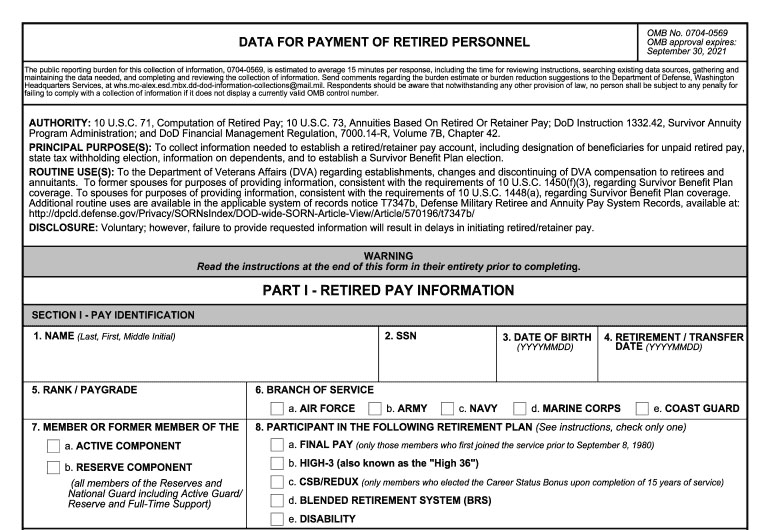Table of Contents
A survivor benefit plan is an insurance policy for survivors of U.S. active-duty military veterans. Just as we purchase car insurance, life insurance, and home insurance to protect those assets, a survivor benefit plan allows military veterans to protect their retirement pay on behalf of their dependent survivors.
A survivor benefit plan is an optional program that a service member must choose to join. The program is not administered by the U.S. Department of Veterans Affairs.
Who Is Eligible for a Survivor Benefit Plan?
- Spouse and Children
- Children Only
- Spouse Only
- Former Spouse
- Natural Interest Person (NIP)
Much like a traditional life insurance policy, a survivor benefit plan protects a veteran’s surviving family members from losing the entirety of the veteran’s retirement benefits upon the veteran’s death. Without SBC coverage, a military retiree’s retirement pay ends with the veteran’s death, so it makes sense to protect this vital asset.
Since the survivor benefit plan is structured as an annuity, it also protects survivors against outliving the benefits available, paying a set monthly amount for the duration of the survivor’s life. Survivors are also protected against the erosion of their buying power through inflation—their benefit amounts will be periodically adjusted to account for inflation through a cost of living adjustment.
What Is a Survivor Benefit Plan?
A survivor benefit plan is an elective insurance policy that members of the U.S. military may choose to buy into at the time of retirement. This type of plan allows an active duty military veteran to ensure, after his or her death, that their dependents continue to receive a lifetime annuity. This annuity, which is based on a percentage of the veteran’s retired pay, is called the SBP and pays eligible survivors an inflation-adjusted monthly income for life.
The way it works is that a military retiree pays for SBP coverage out of retirement benefits. Since it is taken from gross, not net, benefits, the cost for the plan is a pre-tax benefit that lowers overall taxable income. These premiums are partially subsidized by the federal government, so their costs are much lower than what you would see for a traditional life insurance plan.
It’s important to note that a survivor benefit plan is not offered or administered by the VA. Instead, it is managed by the Defense Finance and Accounting Service. This agency is part of the U.S. Department of Defense, created in 1991 to standardize, consolidate and improve accounting and financial functions throughout the defense department. While SBP coverage is not directly administered by the VA, a veteran’s election to participate in SBP coverage may affect some VA disability benefits, such as DIC payments.
Who Is Eligible for a Survivor Benefit Plan?
The following types of family members are most commonly named as eligible beneficiaries for SBP coverage.
Spouse and Children
For veterans with both a spouse and children, it is most common for the spouse to be named as a primary SBP beneficiary. In this case, the children will directly receive the SBP benefit only upon the death of the surviving spouse. Adding children to a survivor benefit plan will increase the cost. This added cost depends on the age of the retiree, the spouse, and the youngest child.
An eligible dependent child must be the veteran’s legal child under age 18 – or, if older than age 18, enrolled in an accredited college or university. In addition, the eligible child must be unmarried. Dependent children who are enrolled in higher education remain eligible until they reach age 22 or leave school.
Incapacitated or disabled children of any age also are eligible for plan coverage. For purposes of the survivor benefit plan, an incapacitated or disabled child is defined as:
A child who is incapable of self-support because of a physical or mental disability that existed before the child’s 18th birthday, or
The disability occurred before the eligible child turned 22 while the child was pursuing a full-time course of study.
Children Only
A married veteran may choose to cover only dependent children, with a signed agreement from the current spouse. If the spouse signs in agreement, or if the veteran is unmarried, the veteran may elect to cover dependent children. The costs for this type of plan depend on the age of the retiree and the age of the youngest child.
Spouse Only
This is the most commonly chosen recipient of a survivor benefit plan – the annuity amount for a spouse typically is based on 55% of the veteran’s retirement income.
Former Spouse
If a veteran has a former spouse at the time of retirement and is eligible to participate in a survivor benefit plan, the veteran may elect former spouse coverage at that time. There are a few scenarios to consider. For example, if a veteran is married at the time of retirement and also has a former spouse that the veteran is court-ordered to cover, the veteran may choose former spouse coverage without the signature of the current spouse. But – if the married veteran chooses to voluntarily cover a former spouse, the current spouse also will need to be notified that the veteran has elected to do so.
Natural Interest Person (NIP)
Unmarried veterans without eligible dependent children may also elect to enroll for coverage of another person in whom the veteran has a legitimate insurable interest. Some examples may include a sibling or a child who does not qualify for conventional child coverage. One point to be aware of, though, is that the SBP premium costs for this type of eligible beneficiary are considerably higher than for the others listed here.
FAQs About Survivor Benefit Plans
You likely have more questions about survivor benefit plans, so we’ve outlined some of the most common questions and their answers for you below.
What are some advantages of a Survivor Benefit Plan?
There are many advantages of having a survivor benefit plan. To start, enrolling in such a plan ensures that a veteran’s survivors continue to receive at least some portion of the veteran’s retirement pay even after the veteran’s death. In addition, because the plan pays an annuity, survivors will continue to receive benefits for the rest of their lives. These benefits also are unaffected by the veteran’s or survivors’ age or medical conditions.
Another benefit is that the monthly benefit amount isn’t static – it changes in response to inflation rates according to the Social Security Administration’s COLA, or cost of living adjustment. This means that the buying power of a survivor’s SBP annuity is protected from being eroded by inflation over time. Since the premiums associated with enrolling in a survivor benefit plan are partially subsidized by the federal government, they are generally affordable for most veterans. Additionally, the premiums are taken out of retirement benefits on a pre-tax basis.
What are some disadvantages of a Survivor Benefit Plan?
The disadvantages to a survivor benefit plan are few. The first is that retired veterans have to pay for survivor benefit plan benefits (there is no charge while on active duty). The premium is taken from retirement pay on a pre-tax basis and is capped at no more than 6.5 percent of the military retiree’s gross pay.
The other chief disadvantage is that your benefit elections are difficult to change once you enroll. For example, if a veteran enrolls an eligible spouse or dependent children at the time of retirement and later decides not to have them covered under the plan, it typically is difficult to have any future spouse or children covered under the plan.
Can I receive SBP payments and DIC at the same time?
If you are an eligible survivor who qualifies for dependency and indemnity compensation, but your veteran family member also chose to enroll in a survivor benefit plan, it’s unlikely that you will be able to collect the full benefit amount for both programs. Instead, the Defense Finance and Accounting Service will reduce your SBP by the amount of your dependency and indemnity compensation payment. If your DIC benefit payment is greater than your total SBP payment, then SBP annuity payments will stop. This is known as the SBP/DIC offset.
If the Defense Finance and Accounting Service ends up paying a designated beneficiary more than the offset amount in SBP annuity payments after DIC payments begin, this amount will be considered an overpayment that must be paid back.
How do I enroll in an SBP?

U.S. military members typically enroll in an SBP at the time of retirement. As you prepare for an impending retirement, it’s important to review DD Form 2656 – the Data for Payment of Retired Personnel, which offers instructions regarding your benefit election options. This is also the form you will submit to record your benefit choices. Please note that the form must be signed prior to your retirement date and that your witness must sign the document on the same date you do.
In cases where a spouse’s signature is required, the form must be signed on or after the date of your signature, and both signatures must be received before the retirement date. Please note as well that the notary who witnesses the spouse’s signature must sign the document on the same date as the spouse.
Can I make changes to my plan?
In some cases, you can make changes to your SBC elections, but the process can be difficult. The Defense Finance and Accounting Service recognizes only a few specific circumstances under which it will allow a veteran to change an existing choice.
For example, if a veteran has no spouse or dependent children at the time of retirement, but later marries or has dependent children that the veteran would like to cover, the Defense Finance and Accounting Service will allow changes to be made as long as they are initiated within one year of the marriage date or the birth of a child. Otherwise, veterans generally are not allowed to add spouses or dependent children as beneficiaries if they did not elect to add them at the time of retirement.
How do I cancel my plan?
Veterans who would like to cancel their survivor benefit plan may do so once they have reached the third year of their retirement. The window for cancellation technically begins during the 25th month of retirement. If a spouse is named as the designated beneficiary, the spouse also will need to sign appropriate documentation to cancel the benefit plan.
Is a Survivor Benefit Plan Right for You?
A survivor benefit plan is a great opportunity for U.S. military veterans to provide for their surviving dependents long after their deaths. This program provides an inflation-protected monthly income that is guaranteed to extend for the remainder of the designated beneficiary’s life.
If you’re nearing retirement and thinking about enrolling in a survivor benefit plan, consider your options carefully. It’s important to enroll in the program and accurately identify your beneficiaries at the time of retirement. Otherwise, changes to your plan can be extremely difficult, and in many cases, impossible, to make. With the information presented here, you can make the best possible choice for you and your loved ones.



